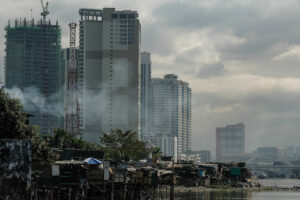By Luisa Maria Jacinta C. Jocson, Reporter
FURTHER monetary easing is seen to prop up gross domestic product (GDP) growth in the Philippines, Fitch Solutions’ unit BMI said, as this would provide much-needed support to domestic demand.
“For the Philippines, we are expecting growth to accelerate from 5.8% in 2024 to 6.3% in 2025. The main driver is monetary policy loosening,” BMI Asia Country Risk Analyst Shi Cheng Low said in a webinar on Tuesday.
The government is targeting 6-8% GDP growth this year.
For the first nine months of 2024, growth averaged 5.8%. Preliminary fourth-quarter and full-year GDP data will be released on Jan. 30.
“Keep in mind that investment has been quite weak in the first quarter and third quarter. So about 150 basis points (bps) of cuts by the end of 2025 should help boost the Philippine economy going forward,” he added.
The Bangko Sentral ng Pilipinas (BSP) began its easing cycle in August last year, delivering 75 bps worth of cuts for 2024.
The central bank has signaled further easing this year as the current policy rate at 5.75% is still in “restrictive territory,” BSP Governor Eli M. Remolona, Jr. said.
Mr. Low said another growth driver is the rebound in private consumption as inflation continues to ease.
Headline inflation averaged 3.2% in 2024, within the 2-4% central bank target.
“We expect inflation to stay within the target for the rest of the year, obviously barring external shocks and also because the labor market has actually been improving,” he said.
This year, the BSP expects inflation to average 3.3%.
However, Mr. Low said their growth forecast for this year hinges on the expectation that US President-elect Donald J. Trump would not be aggressive in the implementation of his tariff proposals.
“If that’s the case, we are going to lower our projections downwards. And I think that’s the biggest risk for the Philippines because the US is one of [its] biggest trading partners,” he said.
Mr. Trump, who is set to assume the presidency on Jan. 20, has pledged to impose import tariffs of up to 10% across the globe and 60% for Chinese goods.
“In sum, we expect the growth outlook to improve at least for the Philippines over the coming quarters,” Mr. Low added.
SERVICE BOOSTMeanwhile, HSBC in a separate commentary said the Philippines is expected to be one of the fastest-growing economies in Southeast Asia, mainly driven by a boost in services.
HSBC Global Private Banking and Wealth Chief Investment Officer for Southeast Asia and India James Cheo said the Philippine economy is “expected to deliver one of the strongest growths in the region this year.”
HSBC expects the Philippines’ GDP to expand by 6.3% this year and 6.7% in 2026.
“Philippine economic growth in 2025 will be driven by robust domestic consumption, a thriving business process outsourcing (BPO) sector, and increasing investments in digital services.”
“The country’s unique strength in service exports, including IT and BPO services, provides a buffer against global trade uncertainties and tariff risks.”
Data from the BSP showed the Philippines booked $37.4 billion worth of services exports in the first nine months, up 6.25% from a year earlier.
“Service exports and overseas remittances, which remain key economic pillars, will continue to contribute significantly to economic resilience and stability in the Philippines,” Mr. Cheo said.
He also said the country’s monetary and fiscal policies are “aligned to support growth while managing risks.”
Mr. Cheo said the central bank would likely deliver further rate cuts this year.
“We forecast the BSP to cut the policy rate to 5% in the third quarter of 2025, as it cautiously navigates external risks like potential volatility in the peso and the US Federal Reserve’s easing cycle.”
“On the fiscal side, the government’s infrastructure agenda remains a key growth driver, supported by revenue-enhancing measures,” he added.
Meanwhile, HSBC expects the peso to “face volatility from a stronger dollar but its high carry will be a buffer.”
“We are bullish on the peso and expect it to stay resilient at P59.8 against the US dollar by end-2025.”
The peso closed at P58.62 a dollar on Tuesday, strengthening by eight centavos from its P58.70 finish on Monday. Last year, the peso fell to a record-low P59-a-dollar level thrice.
MONETARY POLICY BUFFERMeanwhile, Bank of America (BofA) Global Research in a separate report said economies in Southeast Asia might need to deploy varying policies to cushion the spillovers from Mr. Trump’s tariff plans.
“If trade shocks materialize, we reckon that the fiscal-monetary policy mix to cushion any softening of external demand may differ across countries,” it said.
“We think that policy mix may be more balanced in the case of Malaysia and Singapore, more skewed towards fiscal policies for Indonesia and Vietnam, and more skewed towards monetary policies for the Philippines and Thailand.”
For the Philippines, BofA said monetary policy “may have to play a greater role.”
“Inflation is at more manageable levels after the reduction of rice import duties in mid-2024, and BSP is less sensitive to FX (foreign exchange) movements compared with Bank Indonesia,” it said.
“As such, BSP could pursue deeper policy rate and RRR cuts. On the other hand, the government has less scope to raise spending significantly, with the fiscal deficit target for 2025 already above 5% of GDP and government debt at record high levels.”

